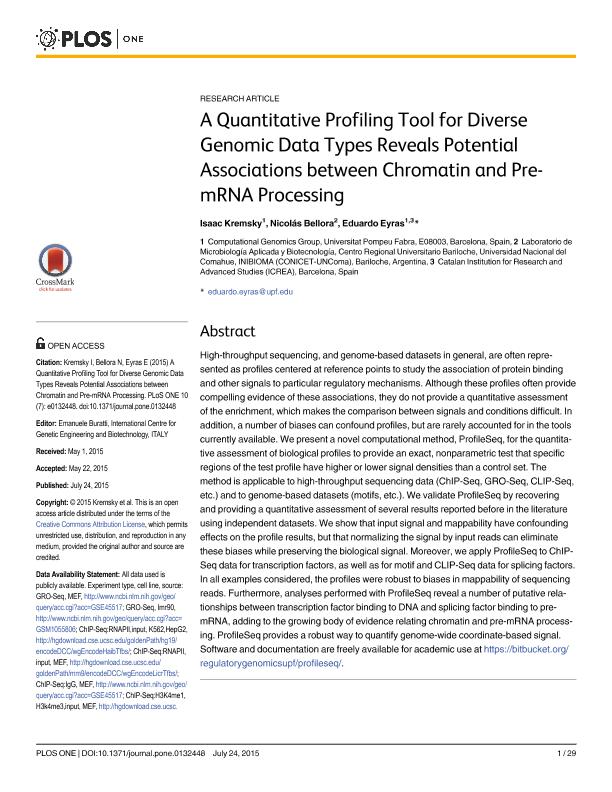Mostrar el registro sencillo del ítem
dc.contributor.author
Kremsky, Isaac
dc.contributor.author
Bellora, Nicolás

dc.contributor.author
Eyras, Eduardo
dc.date.available
2017-01-26T20:56:55Z
dc.date.issued
2015-07
dc.identifier.citation
Kremsky, Isaac ; Bellora, Nicolás; Eyras, Eduardo ; A Quantitative Profiling Tool for Diverse Genomic Data Types Reveals Potential
Associations between Chromatin and PremRNA Processing; Public Library Of Science; Plos One; 10; 7; 7-2015; 1-29
dc.identifier.issn
1932-6203
dc.identifier.uri
http://hdl.handle.net/11336/12050
dc.description.abstract
High-throughput sequencing, and genome-based datasets in general, are often represented as profiles centered at reference points to study the association of protein binding and other signals to particular regulatory mechanisms. Although these profiles often provide compelling evidence of these associations, they do not provide a quantitative assessment of the enrichment, which makes the comparison between signals and conditions difficult. In addition, a number of biases can confound profiles, but are rarely accounted for in the tools currently available. We present a novel computational method, ProfileSeq, for the quantitative assessment of biological profiles to provide an exact, nonparametric test that specific regions of the test profile have higher or lower signal densities than a control set. The method is applicable to high-throughput sequencing data (ChIP-Seq, GRO-Seq, CLIP-Seq, etc.) and to genome-based datasets (motifs, etc.). We validate ProfileSeq by recovering and providing a quantitative assessment of several results reported before in the literature using independent datasets. We show that input signal and mappability have confounding effects on the profile results, but that normalizing the signal by input reads can eliminate these biases while preserving the biological signal. Moreover, we apply ProfileSeq to ChIP-Seq data for transcription factors, as well as for motif and CLIP-Seq data for splicing factors. In all examples considered, the profiles were robust to biases in mappability of sequencing reads. Furthermore, analyses performed with ProfileSeq reveal a number of putative relationships between transcription factor binding to DNA and splicing factor binding to pre-mRNA, adding to the growing body of evidence relating chromatin and pre-mRNA processing. ProfileSeq provides a robust way to quantify genome-wide coordinate-based signal. Software and documentation are freely available for academic use at https://bitbucket.org/regulatorygenomicsupf/profileseq/.
dc.format
application/pdf
dc.language.iso
eng
dc.publisher
Public Library Of Science

dc.rights
info:eu-repo/semantics/openAccess
dc.rights.uri
https://creativecommons.org/licenses/by/2.5/ar/
dc.subject
High-Throughput Sequencing
dc.subject
Genomics
dc.subject
Profiling
dc.subject
Bioinformatics
dc.subject.classification
Biología

dc.subject.classification
Ciencias Biológicas

dc.subject.classification
CIENCIAS NATURALES Y EXACTAS

dc.title
A Quantitative Profiling Tool for Diverse Genomic Data Types Reveals Potential
Associations between Chromatin and PremRNA Processing
dc.type
info:eu-repo/semantics/article
dc.type
info:ar-repo/semantics/artículo
dc.type
info:eu-repo/semantics/publishedVersion
dc.date.updated
2016-12-12T14:23:24Z
dc.journal.volume
10
dc.journal.number
7
dc.journal.pagination
1-29
dc.journal.pais
Estados Unidos

dc.journal.ciudad
San Francisco
dc.description.fil
Fil: Kremsky, Isaac . Universitat Pompeu Fabra; España
dc.description.fil
Fil: Bellora, Nicolás. Consejo Nacional de Investigaciones Científicas y Técnicas. Centro Científico Tecnológico Patagonia Norte. Instituto de Investigación En Biodiversidad y Medioambiente; Argentina. Universidad Nacional del Comahue. Centro Regional Universidad de Bariloche. Departamento de Biologia. Laboratorio de Microbiologia Aplicada y Biotecnologia; Argentina
dc.description.fil
Fil: Eyras, Eduardo . Institució Catalana de Recerca I Estudis Avancats; España
dc.journal.title
Plos One

dc.relation.alternativeid
info:eu-repo/semantics/altIdentifier/url/http://journals.plos.org/plosone/article?id=10.1371/journal.pone.0132448
dc.relation.alternativeid
info:eu-repo/semantics/altIdentifier/doi/http://dx.doi.org/10.1371/journal.pone.0132448
Archivos asociados
